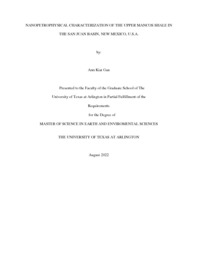| dc.description.abstract | The San Juan Basin is no stranger to oil and gas production and the Mancos Shale is one of the formations of the basin that had been producing petroleum since the early 1920’s as conventional, and recently as, unconventional resources. Due to the economic significance of shale oil and gas production, oil and gas companies have a strong motivation to understand the petrophysical property measurements of shale reservoirs, in this case, the Upper Mancos Shale, both in the laboratory and in the subsurface. By understanding shale petrophysics, such as total organic carbon, mineral composition, wettability, porosity, permeability, pore connectivity for pore space at the nanometer scale, and understanding the pore structure of, and fluid migration, within the shale, these can be utilized to improve and optimize drilling practices to achieve the ultimate goal of enhanced wellbore stability and ultimately, increase shale oil and gas production and recovery. In order to understand the nano-petrophysics of the Upper Mancos Shale with low porosity and extremely low permeability, which is critical in assessing the reservoir quality, a series of experiments will be performed in the laboratory on core samples. These experiments are low-pressure nitrogen physisorption, helium pycnometry for densities measurements, water immersion porosimetry after vacuum pulling, contact angle, and liquid imbibition. In addition, this thesis will obtain supplementary data for total organic carbon content, X-ray diffraction, and pyrolysis from GeoMark Research. XRD analyses show that carbonate content increases in the northeastern part of the San Juan Basin, while the more silica-rich facies are found in the southwest region of the Basin. N2 physisorption indicates that all the samples are microporous, mesoporous and macroporous, with macropores as the most dominant pore distribution. The majority of the samples was evenly distributed between Argillaceous Siliceous Mudstone and Mixed Mudstone with six samples each. The matura tion by Calculated Vitrinite Reflectance (% Ro) from T max and TOC increases from the southwest to northeast region of the Basin, and there are high TOC contents on the east and west flank of the Basin. The fluid imbibition experiment shows that the samples have intermediate to well connectivity with hydrophilic fluid and well connectivity pore network with hydrophobic fluid, whereas the contact angle results show that all the samples are moderately strongly water wet and strongly oil wet. The helium pycnometry and 2DT vacuum saturation results show that the porosity decreases with depth, and there is an inverse relationship between porosity and bulk density from the 2DT vacuum saturation and helium pycnometry test. | |


